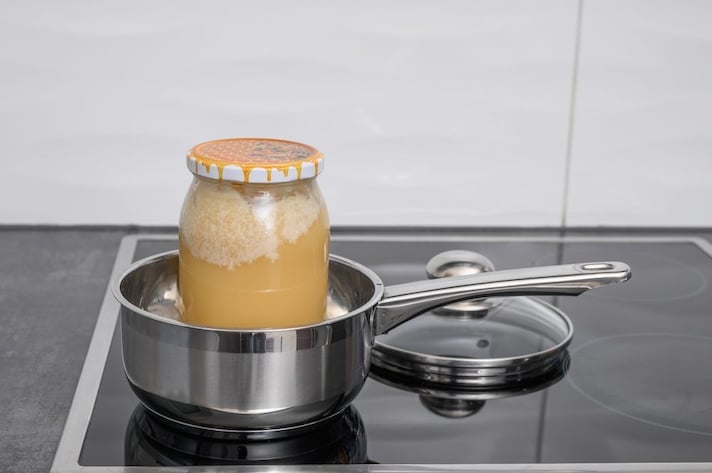How to Melt Honey Without Ruining It: Methods and Tips
Having honey at home is always useful but sometimes it can happen that it ends up crystallizing, that is, becoming very hard. Don't even think about throwing it away. All you have to learn is how to dissolve it: there are different solutions and we will tell you the most effective ones.

What's better than honey? Among the products offered by nature, it is one of the most delicious but also one of the most useful: not only is it rich in beneficial properties – which is why it is also used a lot in the pharmaceutical and cosmetic fields – but it is also extremely versatile. You can use it as a sweetener in your hot drinks, but also as an ingredient in dozens of sweet and savory recipes.
In short, honey should never be missing from your home. However, if you have a jar that has been open for a while or that you haven't closed properly, it may happen that the honey is no longer liquid but has hardened. If you've thought about throwing it away, stop right away: you can still use it without any worries, you just have to melt it to bring it back to a liquid state. How to do it? There are different methods for melting honey that has crystallized (this isn't a bad thing, it's a sign that you have natural honey, not treated or artificial honey): here's a guide on the most effective solutions for making honey liquid again without losing its nutrients and organoleptic characteristics.
Just remember that the more times you melt honey, the more it will degrade: it is therefore better not to subject it to the melting process for more than a couple of times. A good solution can be to take only the quantity you need to melt to avoid ruining the entire jar. Also remember that crystallized honey can be used as it is, for example as a sweetener in hot drinks.
How to Melt Honey in a Bain-Marie
One of the best methods for melting honey without ruining it is the classic bain-marie: it is true that it is a little slower as a technique than others, but this way you are sure that the product maintains all its excellent characteristics. If you need to melt all the crystallized honey and it is in a glass container you can put the jar directly in a pan containing enough water to reach the level of the honey contained inside. When the water starts to boil, remove the pan from the heat and place it on a heat-resistant surface, thus allowing the heat to melt the liquid but without subjecting the honey to excessive temperatures ( over 122°F/50°C the heat ruins the characteristics of the honey). Some precautions: make sure that the jar is at room temperature otherwise the heat of the boiling water could make it explode and, for the same reason, screw the cap on without tightening too much so that no water enters but there is a vent to avoid a build-up of gas. Remove the cap every now and then to stir the melting honey, this will help the heat to pass evenly and speed up the melting process.

How to Melt Honey in The Microwave
If you only need to melt a small part of the crystallized honey, the microwave is a solution, even if it is not one of the best: in a very short time the honey will be perfectly melted, just like chocolate. However, be careful to follow the correct procedure to avoid ruining the product, especially when it comes to the temperature of the microwave and the permanence of the product inside. Once you have placed the honey in a container suitable for the microwave, opt for a medium power to use for about 30/40 seconds, then remove the honey, mix with a spoon and, if it still has lumps, repeat the procedure for another 30 seconds until it is completely melted. The downside is that the honey, in contact with the strong heat of the microwave, loses some of its nutrients, which is why this technique is recommended for recovering small quantities of honey and not for the entire jar.

Melt Crystallized Honey in The Sun
A totally natural decrystallization process is the most homely of all: melt crystallized honey in the sun, obviously if you are in a season warm enough to allow the rays to melt the honey. It is a somewhat “rough” but very effective solution if you do not have a stove or a microwave oven available, but be careful to prefer glass jars and avoid putting honey exposed to the sun in plastic ones, because too much heat could release micro-plastics that would end up inside the product.
Dilute Honey to Soften It (But Only With Raw Honey)
You may find yourself dealing with raw honey, which, mind you, is not the same as crystallized honey: raw honey is a product that has not undergone any type of heat treatment or filtering, which is why it has a dense and grainy consistency, but also a greater amount of nutritional properties and flavor. In this case, the best way to make it more liquid is to dilute it: put the amount of raw honey you need in a container, add a teaspoon of water and mix until it softens and, if it is still not enough, add a little more water and repeat the process. What is important, in the dilution technique, is to proceed gradually so as to avoid watering down the honey. If you do things the right way, you will have honey that has kept all its nutritional properties intact, but remember that this method is not good for industrial honey that has crystallized because, having already been treated, the water would only ruin it.
;Resize,width=767;)



